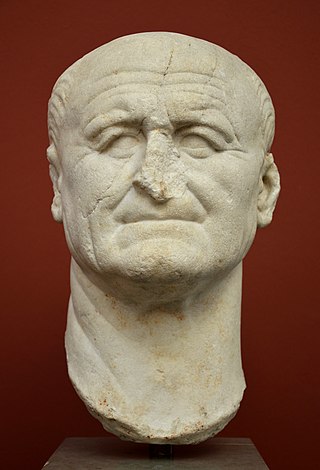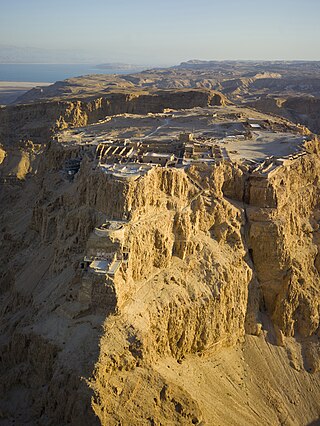
Flavius Josephus or Yosef ben Mattityahu was a Roman–Jewish historian and military leader. Best known for writing The Jewish War, he was born in Jerusalem—then part of the Roman province of Judea—to a father of priestly descent and a mother who claimed royal ancestry.

Vespasian was Roman emperor from 69 to 79. The last emperor to reign in the Year of the Four Emperors, he founded the Flavian dynasty, which ruled the Empire for 27 years. His fiscal reforms and consolidation of the empire brought political stability and a vast building program.
AD 70 (LXX) was a common year starting on Monday of the Julian calendar. At the time, it was known as the Year of the Consulship of Vespasian and Titus. The denomination AD 70 for this year has been used since the early medieval period, when the Anno Domini calendar era became the prevalent method in Europe for naming years.

Titus Caesar Vespasianus was Roman emperor from 79 to 81. A member of the Flavian dynasty, Titus succeeded his father Vespasian upon his death, becoming the first Roman emperor to succeed his biological father.

Berenice of Cilicia, also known as Julia Berenice and sometimes spelled Bernice, was a Jewish client queen of the Roman Empire during the second half of the 1st century. Berenice was a member of the Herodian Dynasty that ruled the Roman province of Judaea between 39 BC and 92 AD. She was the daughter of King Herod Agrippa I and Cypros and a sister of King Herod Agrippa II.

The Hasmonean dynasty was a ruling dynasty of Judea and surrounding regions during the Hellenistic times of the Second Temple period, from c. 140 BCE to 37 BCE. Between c. 140 and c. 116 BCE the dynasty ruled Judea semi-autonomously in the Seleucid Empire, and from roughly 110 BCE, with the empire disintegrating, Judea gained further autonomy and expanded into the neighboring regions of Perea, Samaria, Idumea, Galilee, and Iturea. The Hasmonean rulers took the Greek title basileus ("king") as the kingdom became a regional power for several decades. Forces of the Roman Republic intervened in the Hasmonean Civil War in 63 BCE and made it into a client state, marking the decline of Hasmonean dynasty; Herod the Great displaced the last reigning Hasmonean client-ruler in 37 BCE.

The First Jewish–Roman War, sometimes called the Great Jewish Revolt, or The Jewish War, was the first of three major rebellions by the Jews against the Roman Empire fought in the province of Judaea, resulting in the destruction of Jewish towns, the displacement of its people and the appropriation of land for Roman military use, as well as the destruction of the Jewish Temple and polity.

The siege of Masada was one of the final events in the First Jewish–Roman War, occurring from 72 to 73 CE on and around a hilltop in present-day Israel.
Tiberius Julius Alexander was an equestrian governor and general in the Roman Empire. Born into a wealthy Jewish family of Alexandria but abandoning or neglecting the Jewish religion, he rose to become the 2nd procurator of Judea under Claudius. While Prefect of Egypt (66–69), he employed his legions against the Alexandrian Jews in a brutal response to ethnic violence, and was instrumental in the Emperor Vespasian's rise to power. In 70, he participated in the Siege of Jerusalem as Titus' second-in-command. He became the most powerful Jew of his age, and is ranked as one of the most prominent Jews in military history.

The Jewish–Roman wars were a series of large-scale revolts by the Jews of Judaea and the Eastern Mediterranean against the Roman Empire between 66 and 135 CE. The First Jewish–Roman War and the Bar Kokhba revolt were nationalist rebellions, striving to restore an independent Judean state, while the Diaspora revolt was more of an ethno-religious conflict, mostly fought outside the province of Judaea. As a result, there is variation in the use of the term "Jewish-Roman wars." Some sources exclusively apply it to the First Jewish-Roman War and the Bar Kokhba revolt, while others include the Kitos War as well.

The Siege of Jerusalem of 70 CE was the decisive event of the First Jewish–Roman War, in which the Roman army led by future emperor Titus besieged Jerusalem, the center of Jewish rebel resistance in the Roman province of Judaea. Following a five-month siege, the Romans destroyed the city and the Second Jewish Temple.

Judaea was a Roman province from 6 to 132 AD, which incorporated the Levantine regions of Idumea, Philistia, Judea, Samaria, and Galilee, extending over parts of the former regions of the Hasmonean and Herodian kingdoms of Judea. The name Judaea was derived from the Iron Age Kingdom of Judah, that was centered predominantly in Judea.
Simon bar Giora was the leader of one of the major Judean rebel factions during the First Jewish–Roman War in 1st-century Roman Judea, who vied for control of the Jewish polity while attempting to expel the Roman army, but incited a bitter internecine war in the process.
John of Gischala was a leader of the first Jewish revolt against the Romans.
Eleazar ben Simon was a Zealot leader during the First Jewish-Roman War who fought against the armies of Cestius Gallus, Vespasian, and Titus Flavius. From the onset of the war in 66 CE until the destruction of the temple in 70 CE, he fought vehemently against the Roman garrisons in Judea and against his fellow Jewish political opponents in order to establish an independent Jewish state at Jerusalem. Although the Jewish defeat at Jerusalem cannot be entirely attributed to Eleazar ben Simon, his inability to establish unity with John of Gischala and Simon bar Giora resulted in a bitter civil war that weakened the Jewish resistance against Rome. Eleazar ben Simon and his Zealots' radical anti-Roman policies and eradication of the moderate temple aristocracy from Jerusalem in 67 CE also prevented any peaceful agreement with Rome to avoid the death and destruction which ensued in 70 CE.
Siege of Jerusalem is the title commonly given to an anonymous Middle English epic poem created in the second half of the 14th century. The poem is composed in the alliterative manner popular in medieval English poetry, especially during the period known as the "alliterative revival", and is known from nine surviving manuscripts, an uncommonly high number for works of this time.

The Zealot Temple siege was a short siege of the Temple in Jerusalem fought between Jewish factions during the First Jewish–Roman War. According to the historian Josephus, the forces of Ananus ben Ananus, one of the heads of the Judean provisional government and former High Priest of Israel, besieged the Zealots who held the Temple. When John of Gischala led the Zealots to believe that Ananus had contacted the Roman general Vespasian for assistance in retaking control of all Jerusalem, the Zealots, driven to desperation, asked the Edomites (Idumeans) for assistance in preventing the delivery of the city to the Romans. When the Edomites arrived, the Zealots opened the gates of Jerusalem to them, and the Edomites slaughtered ben Hanan's forces, killing him as well.
Caesar's Messiah is a 2005 book by Joseph Atwill that argues that the New Testament Gospels were written by a group of individuals connected to the Flavian family of Roman emperors: Vespasian, Titus and Domitian. The authors were mainly Flavius Josephus, Berenice, and Tiberius Julius Alexander, with contributions from Pliny the Elder. Although Vespasian and Titus had defeated Jewish nationalist Zealots in the First Jewish–Roman War of 70 AD, the emperors wanted to control the spread of Judaism and moderate its political virulence and continuing militancy against Rome. Christianity, a pacifist and pro-Roman authority religion, was their solution.

The Hasmonean Civil War was a civil war between two claimants to the Hasmonean Jewish Crown. What began as an inter-Jewish conflict became a highly decisive conflict that included the Nabataean Kingdom and ended with Roman involvement. This conflict resulted in the loss of Jewish independence.
The Galilee campaign, also known as the Northern Revolt, took place in the year 67, when Roman general Vespasian invaded Galilee under the orders of Emperor Nero in order to crush the Great Revolt of Judea. Many Galilean towns gave up without a fight, although others had to be taken by force. By the year 68, Jewish resistance in the north had been crushed, and Vespasian made Caesarea Maritima his headquarters and methodically proceeded to cleanse the coastline of the country, avoiding direct confrontation with the rebels at Jerusalem.











